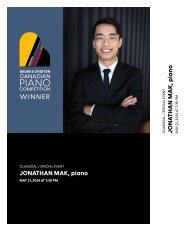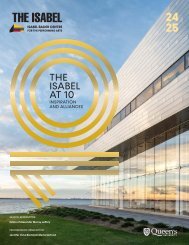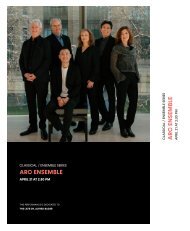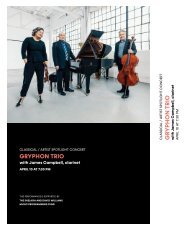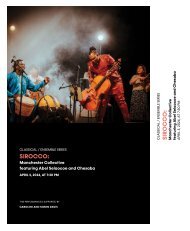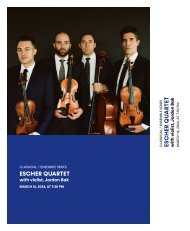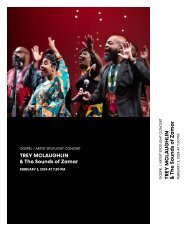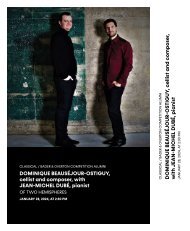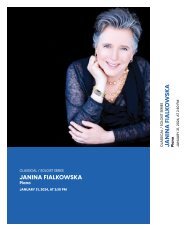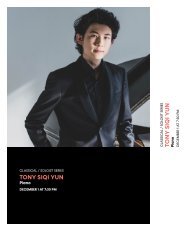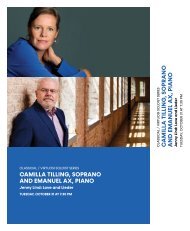Capella Cracoviensis | November 25, 2023 | House Program
Create successful ePaper yourself
Turn your PDF publications into a flip-book with our unique Google optimized e-Paper software.
only uses chromatic dissonance to equally inspire<br />
expressiveness, but also displays a high-level of<br />
imitative counterpoint where the same melodic<br />
idea moves through all five parts.<br />
Giovanni Gabrieli, the principal organist and<br />
composer of Venice’s St. Mark’s Basilica from<br />
1585 until his death in 1612, benefited from<br />
the mentorship of his uncle, Andrea Gabrieli,<br />
and similarly returned the favour to the many<br />
composers who visited Venice from across<br />
Europe, including Heinrich Schütz. The three,<br />
4-part choirs that Giovanni Gabrieli used in<br />
dialogue in the Magnificat setting is an excellent<br />
example of resonantly glorious choral writing and<br />
Zieleński’s 12-part version is similarly impressive.<br />
Another Venetian composer, Claudio Monteverdi<br />
(1567-1643), was equally adept at writing<br />
beautiful choral music that combines chordal<br />
writing with florid counterpoint as can be heard<br />
in this six-part setting of the Good Friday text,<br />
Adoramus te, Christe (We Adore Thee, O Christ).<br />
J.S. Bach knew and studied the music of Heinrich<br />
Schütz and Johann Schein, with Schein also<br />
having served as the Cantor of the St. Thomas<br />
Church in Leipzig from 1615-1630, a post Bach<br />
held from 1723-1750. Schütz’s Syncharma<br />
Musicum: En novus Elysiis, is the only secular<br />
work on this program and is a very triumphant<br />
ceremonial motet written for the 1621 swearing<br />
of allegiance of the Silesian nobility to Johann<br />
Georg of Saxony as the representative of<br />
Emperor Ferdinand.<br />
A distant relative of J. S. Bach, the older church<br />
organist and composer, Johann Michael Bach,<br />
later became more closely connected through<br />
marriage when his youngest daughter, Maria<br />
Barbara, married Johann Sebastian in 1707. In<br />
J.M. Bach’s funeral motet, Herr, wenn ich nur<br />
dich haben (Lord, if I have you alone), it is worth<br />
listening closely to the soprano’s ornamented<br />
chorale because it is the same melody used in<br />
the J. S. Bach motet that ends today’s concert.<br />
As with J. M. Bach’s treatment, J.S. Bach places<br />
the chorale melody in the sopranos, but with<br />
contrapuntal ingenuity, treats each phrase of<br />
the melody in imitation in the lower parts<br />
reaching a density of seven separate voices.<br />
©<strong>2023</strong> by John Burge for the Isabel<br />
ABOUT CAPELLA CRACOVIENSIS<br />
<strong>Capella</strong> <strong>Cracoviensis</strong> (CC) chamber choir and<br />
orchestra is one of the most interesting ensembles<br />
on the contemporary scene of period music.<br />
Its repertoire ranges from Renaissance polyphony<br />
to early Romantic operas performed on period<br />
instruments using historical performance<br />
techniques. CC has been hosted at many<br />
important festivals and concerts halls, including<br />
Concertgebouw Amsterdam, Bachfest Leipzig,<br />
SWR Festspiele Schwetzingen, Händel Festspiele<br />
Halle, Haydn Festspiele Brühl, Opéra Royal<br />
Versailles, Theater an der Wien, the Polish<br />
National Radio Symphony Orchestra in Katowice,<br />
Szczecin Philharmonic and the Misteria Paschalia<br />
Festival in Krakow. The ensemble has already<br />
performed with such eminent guests as Evelino<br />
Pidó, Christophe Rousset, Alessandro Moccia,<br />
Giuliano Carmignola, Paul Goodwin, Andrew<br />
Parrott and Paul McCreesh.<br />
One of CC’s greatest successes was the<br />
performance of all Beethoven’s symphonies<br />
on historical instruments within one day, on 27<br />
August 2016 in Krakow, with live transmission<br />
on the radio. The total of 2300 audience<br />
members could appreciate the mastery of 90<br />
instrumentalists, 44 singers and 5 conductors.<br />
The latest achievements of CC include the first<br />
performance of Wagner’s works on historical<br />
instruments with the participation of Waltraud<br />
Meier (Wesendonck-Lieder) and the recording of<br />
the following operas by Pergolesi and Porpora for<br />
Decca Records: Pergolesi: Adriano in Siria (Fagioli<br />
Basso Sancho Adamus) and Porpora: Germanico<br />
in Germania (Cencic Leznieva Adamus) which<br />
was awarded with Diapason d’Or.<br />
CC’s other albums include Te Deum / Lully<br />
& Charpentier with Le Poème Harmonique<br />
(conducted by Vincent Dumestre) and the<br />
recordings of Bach’s motets (conducted by<br />
Fabio Bonizzoni) for Alpha records as well as<br />
the piano concerto in F minor and the unfinished<br />
symphony by Schubert (Klimsiak / Adamus)<br />
for AviMusic.<br />
In May 2018 CC began the six-year project Haydn:<br />
complete symphonies 2018-<strong>2023</strong> including<br />
concerts and live recordings.




